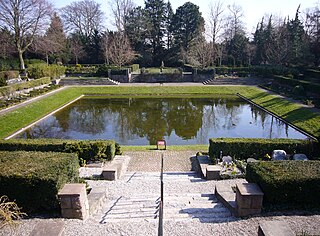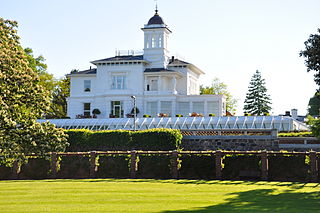
Arne Emil Jacobsen, Hon. FAIA was a Danish architect and furniture designer. He is remembered for his contribution to architectural functionalism and for the worldwide success he enjoyed with simple well-designed chairs.

Gentofte Municipality is a municipality in the Capital Region of Denmark on the east coast of the island of Zealand (Sjælland) in eastern Denmark. It covers an area of 25.54 km2 (9.86 sq mi), and has a total population of 75,033. Since 17 May 2021, its mayor has been Michael Fenger, a member of the Conservative People's Party.

Vestre Cemetery is located in a large park setting in the Kongens Enghave district of Copenhagen, Denmark. With its 54 hectares it is the largest cemetery in Denmark.

The Radisson Collection Royal Hotel, Copenhagen is a historic hotel in Copenhagen, Denmark.

The Copenhagen Harbour Baths are a system of recreational bathing facilities along the waterfront of Copenhagen, Denmark. There are currently four harbour baths, the first and best-known of which is located at Islands Brygge.

Dissing+Weitling is an architecture and design practice in Copenhagen, Denmark. The founders and namesakes Hans Dissing and Otto Weitling founded the firm upon the death of Arne Jacobsen as a continuation of his office where both had been key employees.

The Bellevue Teatret is a theatre in Klampenborg at the northern outskirts of Copenhagen, Denmark. Opened in 1936 to the design of Arne Jacobsen, the building is considered one of his most important architectural works and exemplar of Danish functionalism. The theatre is part of a scheme also including the adjoining Bellevue Beach and residential block and was, at the time, seen as a manifestation of "the dream of the modern lifestyle".

North Zealand, also North Sealand, refers to the northeastern part of the Danish island of Zealand. The Danish tourist authorities have recently introduced the term Danish Riviera to cover the area in view of its increasing importance for tourism. The area has three royal castles and offers resorts with beaches, as well as lakes and forests. In addition to Kronborg Castle, three of the North Zealand forest areas used for royal par force hunting are included in the UNESCO World Heritage List.

Klampenborg is a northern suburb of Copenhagen, Denmark. It is located in Gentofte municipality, directly on Øresund, between Taarbæk and Skovshoved. Like other neighbourhoods along the Øresund coast, Klampenborg is an affluent area with many large houses.

Enghaveparken is a public park in the Vesterbro district of Copenhagen, Denmark. It was laid out in the late 1920s to cater for the citizens of the expanding city.

Hvidøre House is a former country house at Klampenborg, just south of Bellevue Beach, on the Øresund coast north of Copenhagen, Denmark. It is most known for serving as the home of Dowager Empress Maria Feodorovna of Russia, daughter of King Christian IX and mother of the last emperor of Russia, Nicholas II, after she was exiled by the Russian Revolution of 1917. It now serves as a conference and training venue for the Novo Group.

The Bellavista housing estate designed by Arne Jacobsen is the clearest example of Bauhaus architecture in Denmark. Completed in 1934, the estate is located just north of Copenhagen, in Klampenborg, Gentofte Municipality, next to Jacobsen's Bellevue Beach, which had been completed a couple of years earlier.

The Søholm Row Houses, designed by the Danish architect Arne Jacobsen in Klampenborg just north of Copenhagen, were completed in the late 1940s and early 1950s. Together with his Bellavista developments, the Søholm houses helped to establish Jacobsen's international reputation.

Munkegaard School is a school in Gentofte, just north of Copenhagen, designed by the Danish architect Arne Jacobsen and completed in 1957. The complex is considered to be one of Jacobsen's most important architectural works.

Rødovre Town Hall is located at the centre of Rødovre, a municipality some 9 km (5 mi) to the west of Copenhagen's city centre. Completed in 1956, it was designed by the Danish architect Arne Jacobsen. A fine example of the international architecture trends of the 1950s, it was inspired by the General Motors Technical Center to the north of Detroit.

Søllerød Town Hall, now renamed Rudersdal Town Hall, was built for the former Søllerød Municipality which in 2007 became part of Rudersdal Municipality, combining Søllerød and Birkerød. The building is located in Holte some 19 km to the north of Copenhagen's city centre. Designed by Danish architects Arne Jacobsen and Flemming Lassen, it was completed in 1942.

Axeltorv is a public square in central Copenhagen, Denmark, located across the street from Tivoli Gardens' main entrance on Vesterbrogade.

Skovshoved is a former fishing village on the Øresund coast north of Copenhagen, Denmark. The area is part of Charlottenlund postal district and Gentofte Municipality. Local landmarks include Skovshoved Church, Skovshoved Hotel and the listed Arne Jacobsen-designed Skovshoved Petrol Station from 1938.
Køge Bugt Strandpark is a seaside public park in the western suburbs of Copenhagen, Denmark, reaching from Avedøre Holme in the northeast to Greve Strand in the southwest. It is about 7 km long and has an area of about 5 km2. Four marinas and the Arken Museum of Modern Art is located within the park.

Cottageparken is a public park located on the border between Taarbæk to the north and Klampenborg to the south, adjacent to Jægersborg Dyrehave and Bellevue Beach, on the Øresund coast north of Copenhagen, Denmark. It is most notable for Den Røde Cottage and Den Gule Cottage, the only surviving buildings of Klampenborg Spa which opened at the site in the 1840s. They are now operated as restaurants. Den Røde Cottage has one star in the Michelin Guide. Until 2017 its chef was Anita Klemensen. The park is located within Klampenborg postal district but in Lyngby-Taarbæk Municipality.





















